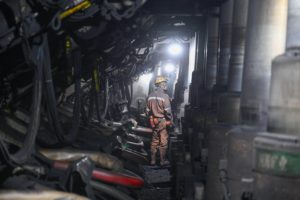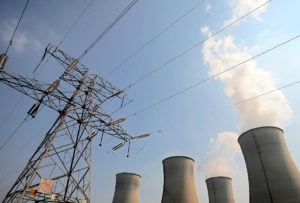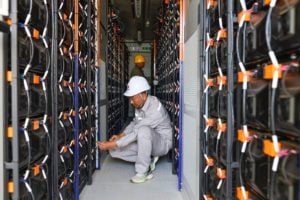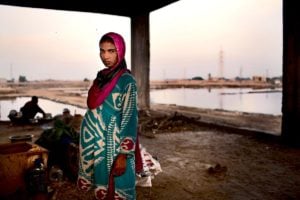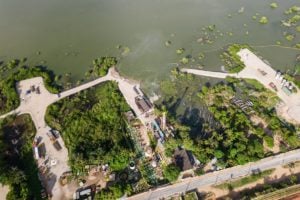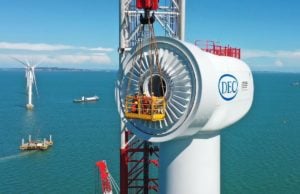Last year the world was warmer than in any since records began.
China experienced a spate of heatwaves, droughts, rainstorms and typhoons. This extreme weather was down to a mixture of human-caused climate change and the return of the El Niño natural weather phenomenon.
We are all more likely to feel the impact of climate change now that extreme weather is the new normal. As a result, energy transition, climate adaptation and related issues have become more pressing than ever.
How China responds to these challenges is crucial, and not just in terms of policy at the macro scale.
With this in mind, and as we enter the Year of the Dragon, we asked civil society groups and academics active in China’s environmental sector about the work they have been doing over the past 12 months. What did they think was the most significant environment-related event or policy of 2023? And what gave them the greatest sense of accomplishment?
Their answers have been edited for length and clarity.
The EU’s new carbon levy, and the growth of coal power in China
Chen Ying, researcher at the Research Institute for Eco-civilization, Chinese Academy of Social Sciences
There was indeed progress on climate change in 2023. At an international level, the COP28 climate conference, with the largest number of participants in its history, reached a consensus on transitioning away from fossil fuels. That event also delivered the first COP “global stocktake” – on progress towards the Paris Agreement targets – since the agreement was signed in 2016. Good progress was also made in relation to the loss and damage fund.
In practical terms, however, the picture was not so encouraging. The EU introduced its Carbon Border Adjustment Mechanism, with a transitional period beginning on 1 October. It is the world’s first carbon-border tax with a punishing effect, which is alarming. We have to be careful it doesn’t turn into a political Pandora’s box, undermining trust and stoking contention. Finding solutions in response to climate change calls for multilateral dialogue and international cooperation. Unilateral penalties are unfair, and cliquish approaches will not solve the problems.
In China, exports of electric vehicles (EVs) hit a new high, of more than 1.2 million units, up 77% year-on-year. In fact, performance was impressive across all of the “three new” exports (EVs, lithium batteries and solar cells), which has helped boost the global low-carbon transition.
On the other hand, the continued expansion of coal power investment is troubling. Energy security concerns had come to the fore following power rationing in Sichuan and Chongqing in 2022, which was a consequence of high temperatures, drought and a shortage of hydropower. As a result, new coal plants had to be added to provide energy security. The number of hours that coal-fired generators were in operation increased in 2023, and in some parts of the country, energy emissions have been rising faster than GDP growth.
But given China’s drive to meet its dual-carbon goals – of peaking emissions by 2030 and reaching carbon neutrality by 2060 – there is a real risk of coal plants becoming stranded assets in the future. Adding coal power may be unavoidable at this point, as we are in the middle of a difficult transition, but it is not sustainable. Pressure for energy security should not be directed solely to the supply side, and it does not make sense to guarantee unlimited supply at very low prices. Coal power is not the only way to achieve energy security. Issues of energy transition and security should be addressed, as far as possible, through approaches that include multi-energy complementarity [integrating the use of different energy types], intelligent dispatch, trans-provincial mechanisms for the power market, and demand-side management.
Since 2009, the Chinese Academy of Social Sciences and China Meteorological Administration have jointly produced an annual climate change Green Book, summarising China’s action, research and data on climate change. In the 15 years since it was launched, we’ve continued to pay attention to – and record – new developments and developments in the field of climate change. Last year marked, once again, the hottest on record for humanity, and the jump was particularly large. Temperature is not the only metric for climate change, and the effects of a changing climate go beyond an increase in recorded heatwaves. New highs are being set across the entire climate system, from ocean heat content to CO2 concentrations, glacier retreat and sea-level rise. The impact on human society is so extensive that it worries me deeply, and underlines the gravity of the challenge.
In today’s dual-carbon era, I’m proud to take on more responsibility on behalf of society. Last year, People’s Daily Press published a book that I edited: Fourteen Lectures on the Dual Carbon Targets and Green, Low-Carbon Development. It was the outcome of a collaboration between more than 20 senior experts and scholars in the field. My hope is that it can help corporate leaders acquire, in a systematic way, the knowledge they need concerning the dual-carbon goals and the “1+N” policy framework, so as to drive forward the nation’s low-carbon transition.
The “1+N” policy framework is designed to guide China’s decarbonisation journey up to 2060. The “1” stands for a top-level Guiding Opinion document, issued in October 2021, while the “N” refers to a set of more than 30 sector-specific decarbonisation plans.
In addition, The Story of ‘Dual-Carbon’ for Teenagers, which I co-authored with among others Chao Qingchen, director of the National Climate Centre, was selected as one of the year’s outstanding works of popular science, for disseminating achievements in environmental science and technology. Popular science is not my main career, but I find it meaningful to help more young people understand carbon neutrality and comprehend a future, carbon-neutral world; one that we may never see but that they will live in and help to build.
COP28 made low-carbon development more tangible
Ma Jun, director of the Institute of Public and Environmental Affairs (IPE), a non-profit research organisation based in Beijing
For me, the most important environmental event of 2023 was COP28 in Dubai, UAE. The conference delivered the first global stocktake since the Paris Agreement, and countries reached a consensus on transitioning away from fossil fuels. It made the prospect of low-carbon development significantly more tangible, while sending a strong signal of unity, action, and working together to deliver commitments.
In terms of policy [in China], I think what’s most important is combining the push for carbon reduction, lower pollution and a broader green economy with high-quality development, as raised in the report of the 20th party congress in 2022.
On the technology front, the most significant development of the past year was the breakthrough advance in artificial intelligence. While this means revolutionary changes for society, it brings numerous potential risks which must be borne in mind. The environmental impact is one. AI’s enormous computational requirements create huge demand for energy and water. The next question to think about is: how can we use AI to speed humanity’s progress towards carbon peaking and neutrality, rather than allow the technology’s rapidly growing energy demand to be a drag on the pace of overall carbon reduction?
How can we use AI to speed humanity’s progress towards carbon peaking and neutrality, rather than allow its energy demand to slow overall carbon reduction?
Another noteworthy trend of the past year was the growing focus on matters of planetary health. Human activity is altering the state of the Earth to the point where we are reaching an unofficial new geological era, the Anthropocene. We will have to learn to respect planetary boundaries and live in harmony with nature, all while protecting human and ecological health.
In 2023, for the 10th consecutive year, we at the IPE carried out our Green Supply Chain Corporate Information Transparency Index (CITI) Evaluation, which assesses companies’ environmental management using publicly available information. We also assisted large financial institutions in gauging the environmental performance of more than a million loan companies, which shows how new applications for environmental big data are emerging.
Getting more Chinese people involved in climate action
Liu Jinmei, director-general, Friends of Nature, a Chinese environmental NGO
What caught my attention the most in 2023 was China’s new air pollution action plan, which delineates the new key regions for mitigation work. The plan raises the number of priority cities listed for air pollution control from 80 to 82, and sets out fine particulate matter pollution (PM2.5) indices and targets for each of the key regions.
Air quality in China improved significantly between 2013 and 2022. But does that mean the war on pollution is over? From my perspective as a practitioner, the action plan sends an important signal: in terms of preventing pollution in China, the job is far from done. We have made real progress in this area, for sure. But from a public health perspective, there is still a long way to go.
There is another significant aspect to the action plan. In 2021 and 2022, pandemic conditions meant many industrial companies could not operate at full capacity. As a result, air quality sharply improved. Following the return to economic normality, and with the drive to make up for losses incurred during the pandemic, a significant rebound in pollution levels was recorded in 2023. The general public directly experienced the difference, and there was a marked increase in recorded pollution days. The concern has been whether pollution controls may be loosened. However, the action plan sends a clear signal that government policy remains firmly anchored in stronger prevention of pollution and continued improvement in air quality.
One trend that I expected to see in 2023 did not materialise: that of an emphasis on adapting to climate change. Its impact, and the damage it causes, are increasingly obvious, but in the policy, technology and finance sectors, and even in the areas of philanthropy and community issues, discussion and engagement have focused mainly on mitigation. It goes without saying that greenhouse gas emissions have to abate as fast as possible, but adapting to climate change, too, is a matter of urgency. China is a country vulnerable to climate change, with complex geographic and meteorological conditions that make adaptation particularly hard. It is therefore something we have to focus on soberly and seriously.
The project that we at Friends of Nature were most proud of in 2023 was our Linglong programme for public climate action. It allows participants and leaders in different fields to respond more effectively to climate issues through individual action.
We hope to inspire and support more young people to care about and take part in climate action
Most participants are not directly involved in environmental work or advocacy. Among them are doctors, teachers, full-time mothers, farmers, convenience store owners and college students. One from our fourth intake, who made a particular impression on me, was a PhD candidate in her gap year. She was aiming, with support from Linglong, to carry out a project relating to climate adaptation for outdoor workers in heatwave conditions. This involved her applying for delivery worker and construction site jobs in order to experience the strain first-hand, then going on to design targeted solutions.
Friends of Nature hopes, through the Linglong programme, to help the public make the connections between themselves and climate change. It’s not just about 1.5C; it’s my daily patterns of consumption and my lifestyle, all of which link to climate change. And then, once I accept I have something to do with climate change, considering what I can do about it.
This is what Friends of Nature aims to offer the wider public, through the Linglong programme and examples of climate action set by Linglong participants, one after another. We hope to inspire and support more young people to care about and take part in climate action, dispelling feelings of anxiety and helplessness through the steps that they take.
Key trends: decarbonising China’s energy system
Yuan Ying, chief China representative at Greenpeace East Asia
Environmentally, I think the most important development of 2023 would be the intensity and frequency of extreme weather events all around the world, China included. From exceptionally heavy rains south of the Yangtze and heatwave conditions in northern India, to the wildfires in Hawaii, we witnessed Earth-system tipping points being repeatedly breached and humanity being thrown out of the “comfort zone” for sustainable life.
The most important trend of the year would be the decarbonisation of China’s energy system. Amid pressure for energy security, social and economic development, and meeting the dual-carbon goals, the power sector saw both significant growth in renewables and an accelerated rate of new coal-plant approvals.
The clean energy sectors accounted for 40% of China’s economic growth last year, while the installed capacity of renewables surpassed that of coal power for the first time. Manoeuvrings to replace coal with renewables will determine how soon emissions from the country’s power sector can peak, and help China meet its dual-carbon goals.
In terms of technology, what stand out are developments in the field of electric vehicles (EVs), including batteries. With Chinese companies having the largest share in the global lithium battery market, the country’s own EV industry and market are both growing apace. China is also expected to become the world’s largest car exporter, and this will help to wean the global industry off internal combustion engines and spur zero-carbon transition across the transportation sector.
Greenpeace has always stood for positive change through action in dealing with the major environmental crises of climate change and biodiversity loss.
At Greenpeace East Asia, these are some of the successes I am most proud of from last year.
We have been both an analyst of – and proponent for – major environmental developments and public policy at home and abroad. While helping bring climate issues to the fore in China, we have tried linking those issues to a wide range of societal concerns.
Our initiatives have included a report on the impacts of climate change on the ecology, industry and cultural heritage of north-west China; more than 100 hours of podcasts; and climate-themed tabletop gaming events across the country.
As part of our work to both monitor and galvanise, we encouraged internet, electronics and automotive business leaders – from companies including ByteDance, Luxshare Precision, TSMC, Vipshop and Geely Auto – to pledge to climate goals such as transitioning to using only renewable energy, and phasing out internal combustion engines.
We launched a system for assessing local momentum for climate action; supported the regions of Beijing-Tianjin-Hebei, Yangtze River Delta and Daya Bay in driving the low-carbon transition; undertook a health check of overseas renewable energy investments; and made policy recommendations, along with providing input on forest and marine issues and helping formulate relevant regulations.
Marine conservation, with an emphasis on social equity
Wang Songlin, founder and chairman of Qingdao Marine Conservation Society (QMCS)
I think the most significant trend of the past year among marine NGOs has been the added focus on social equity in pursuit of solutions to environmental and resource problems. This focus has been on top of the existing attention given to policies, regulations and scientific guidance.
As an example, there is now greater recognition of the value that local, traditional ecological knowledge brings to creating solutions. There is also more focus on earning the understanding, support and participation of coastal communities, particularly those that practise subsistence fishing.
We are starting to see movement in this direction, in the way that statutes and regulations are being amended. Article 30 of the 2022 revised draft for regulations on nature reserves recognises subsistence rights for Indigenous inhabitants of core protected areas. It lists the productive activities and lifestyle practices that such inhabitants and other stakeholders are entitled to engage in, “on the premise that the existing scale and intensity of utilisation will not be expanded”. Although the relevant provisions have not yet been finalised, the draft revision clearly reflects the importance that policymakers attach to upholding social equity. This is in contrast to the original law’s assertion that “no artificial production activities, such as fishing” can be carried out in core marine conservation areas.
The trend extends beyond the sustainable management of fisheries to encompass the conservation of marine biodiversity, adaptation to climate change, conservation and restoration of blue carbon sinks, and reduction of plastic use. However, it also throws up new issues, such as how we will regulate human activity in marine conservation areas, and how we can ensure equity – as well as effective conservation for biodiversity and fishery resources – are maintained in protected zones.
Applying traditional fisheries knowledge in the conservation of marine ecology and fisheries was also emphasised in our work last year. With three consecutive years of funding from the Zhilan Foundation, QMCS and a team of researchers from Xiamen University have collaborated on the study and conservation of seahorses and their habitats in the fishing grounds of southern Fujian, eastern Guangdong and the Taiwan Bank. The project combines the hands-on knowledge and experience of fishers from the region with scientific findings from research in the field.
At the Xiamen team’s invitation, QMCS also contributed to an academic paper on seahorses in China’s waters. The paper, which has been accepted for publication, includes conservation recommendations. We anticipate that groundwork of this kind can help signpost the way as China seeks to realise the “30 by 30” goal for marine conservation under the Kunming–Montreal Global Biodiversity Framework.
